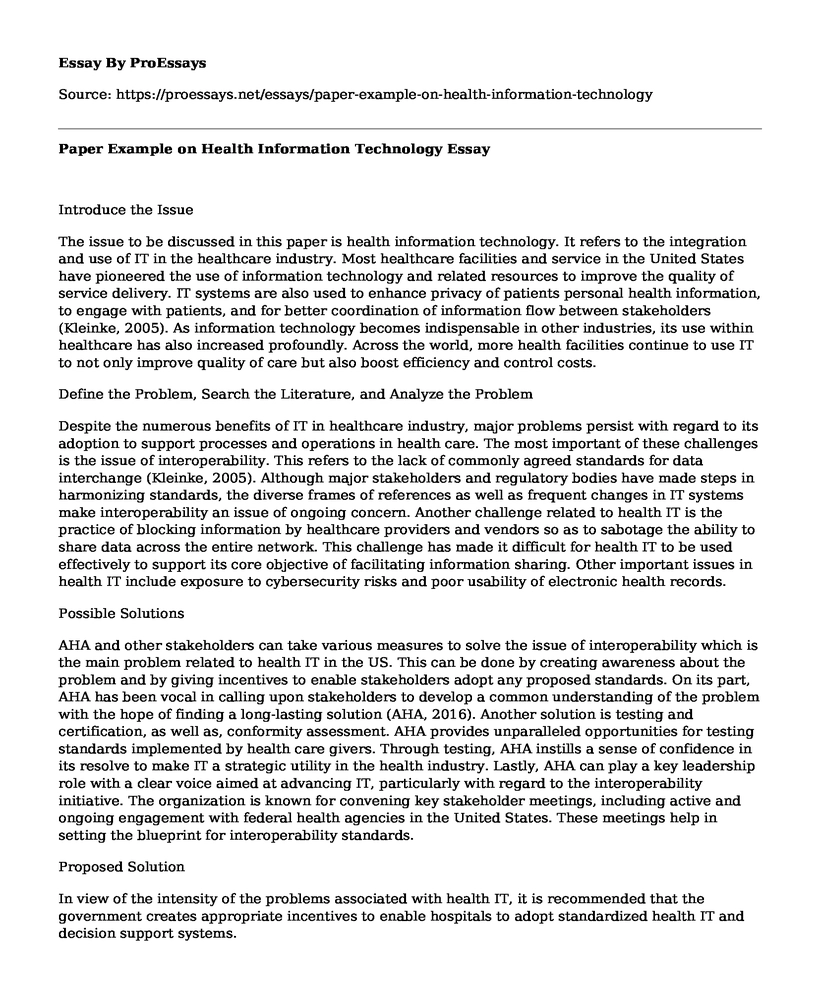Introduce the Issue
The issue to be discussed in this paper is health information technology. It refers to the integration and use of IT in the healthcare industry. Most healthcare facilities and service in the United States have pioneered the use of information technology and related resources to improve the quality of service delivery. IT systems are also used to enhance privacy of patients personal health information, to engage with patients, and for better coordination of information flow between stakeholders (Kleinke, 2005). As information technology becomes indispensable in other industries, its use within healthcare has also increased profoundly. Across the world, more health facilities continue to use IT to not only improve quality of care but also boost efficiency and control costs.
Define the Problem, Search the Literature, and Analyze the Problem
Despite the numerous benefits of IT in healthcare industry, major problems persist with regard to its adoption to support processes and operations in health care. The most important of these challenges is the issue of interoperability. This refers to the lack of commonly agreed standards for data interchange (Kleinke, 2005). Although major stakeholders and regulatory bodies have made steps in harmonizing standards, the diverse frames of references as well as frequent changes in IT systems make interoperability an issue of ongoing concern. Another challenge related to health IT is the practice of blocking information by healthcare providers and vendors so as to sabotage the ability to share data across the entire network. This challenge has made it difficult for health IT to be used effectively to support its core objective of facilitating information sharing. Other important issues in health IT include exposure to cybersecurity risks and poor usability of electronic health records.
Possible Solutions
AHA and other stakeholders can take various measures to solve the issue of interoperability which is the main problem related to health IT in the US. This can be done by creating awareness about the problem and by giving incentives to enable stakeholders adopt any proposed standards. On its part, AHA has been vocal in calling upon stakeholders to develop a common understanding of the problem with the hope of finding a long-lasting solution (AHA, 2016). Another solution is testing and certification, as well as, conformity assessment. AHA provides unparalleled opportunities for testing standards implemented by health care givers. Through testing, AHA instills a sense of confidence in its resolve to make IT a strategic utility in the health industry. Lastly, AHA can play a key leadership role with a clear voice aimed at advancing IT, particularly with regard to the interoperability initiative. The organization is known for convening key stakeholder meetings, including active and ongoing engagement with federal health agencies in the United States. These meetings help in setting the blueprint for interoperability standards.
Proposed Solution
In view of the intensity of the problems associated with health IT, it is recommended that the government creates appropriate incentives to enable hospitals to adopt standardized health IT and decision support systems.
Implementation Plan
The proposed solution can be implemented in phases beginning with federal health care facilities and then state funded and municipal hospitals.
Justification
Incentives will make it easier for most service providers to adopt IT systems. It can be noted that health IT is an important issue in the United States health care system for several reasons. First, it contributes to improved coordination of information from multiple providers across the health sector (Wafa, 2010). Through IT systems, hospitals and other players in the industry can promote better health care by improving management of critical information. For example, IT systems can ensure that patients information is available during emergencies or when they are travelling. This facilitates improved decisions in critical situations (Kleinke, 2005). Secondly, IT systems improve efficiency by reducing administrative costs in health care. Organizations that use health IT can provide patients with convenient access to prescription refills as well as appointment schedules. With health IT, hospital staff can spend less time searching for specific patient information and responding to information requests. Third, health IT enhances communication between health care providers and the patient. As Wafa (2010) explains, majority of health IT systems allow direct communication between the two parties. This communication is secure, fast and convenient for both the patient and health care provider. With such a system of communication, health care providers can intervene early if emergency issues arise. The last major reason why health IT is an important issue is that it encourages self and family management of health. This is especially important for those caring for elderly people and young children at home.
References
AHA (2016). Health information technology. Available at http://www.aha.org/advocacy-issues/hit/index.shtml
Kleinke, J. D. (2005). Dot-Gov: Market Failure and the Creation of a National Health Information Technology System. Health Affairs, 24(5), 1246-1262.
Wafa, T. (2010). How the Lack of Prescriptive Technical Granularity in HIPAA Has Compromised Patient Privacy. Northern Illinois University Law Review, 30, 44-49.
Cite this page
Paper Example on Health Information Technology. (2021, Mar 29). Retrieved from https://proessays.net/essays/paper-example-on-health-information-technology
If you are the original author of this essay and no longer wish to have it published on the ProEssays website, please click below to request its removal:
- Multi-Agency Emergency Event Paper
- Evidence-Based Practice in the Workplace Paper Example
- Skeletal Muscle, Myokines, Obesity and Exercise Paper Example
- Essay Sample on COVID-19: Impact on Supply Chain Management & Strategies for Recovery
- Essay Example on Joint Commission: Socio-Technical Systems in Non-Profit Organizations
- Nursing Students: Professional Behaviour & Dressing Well - Essay Sample
- Essay Example on Homelessness: Ignored Crisis Amidst COVID-19 Pandemic







